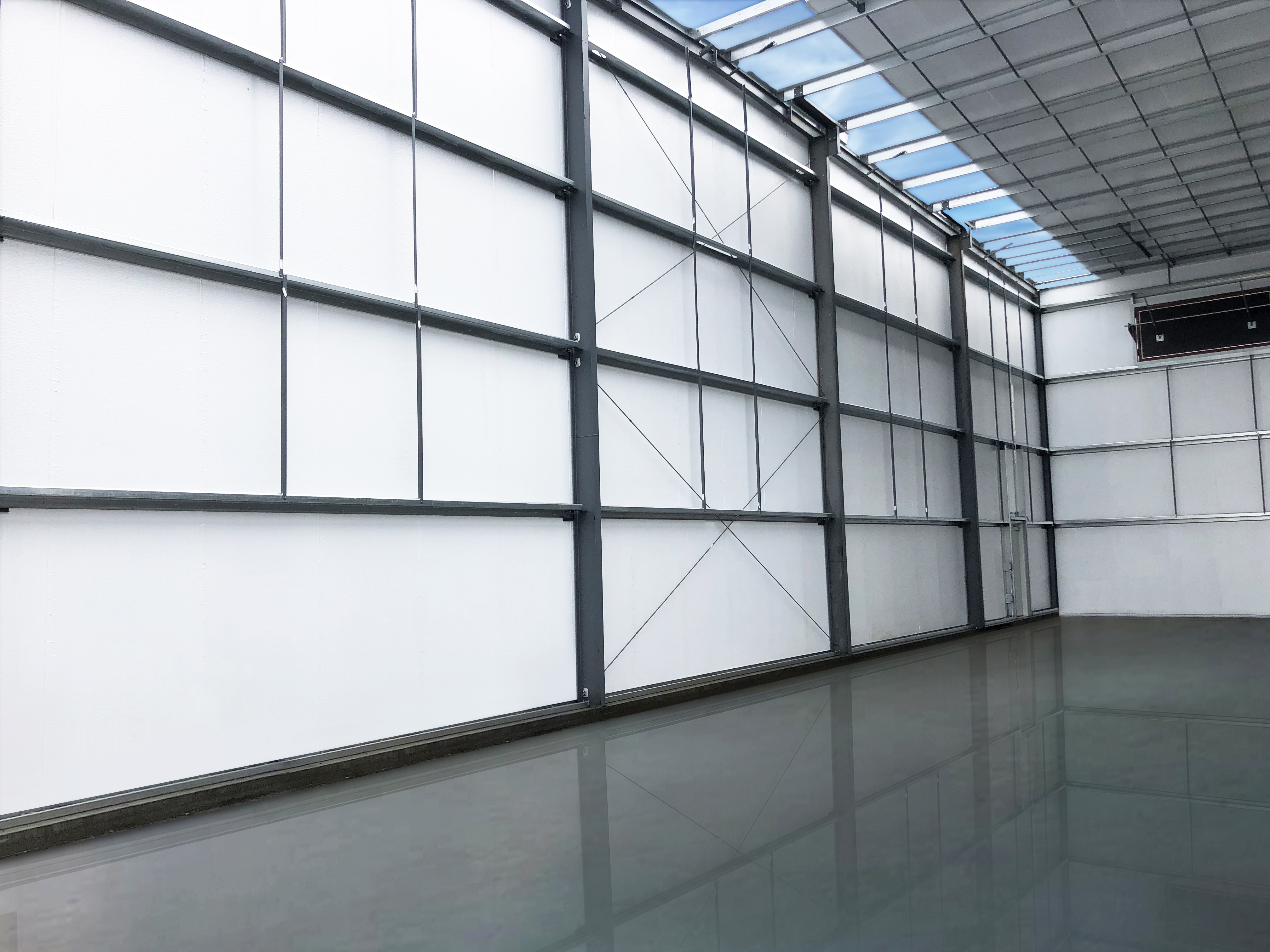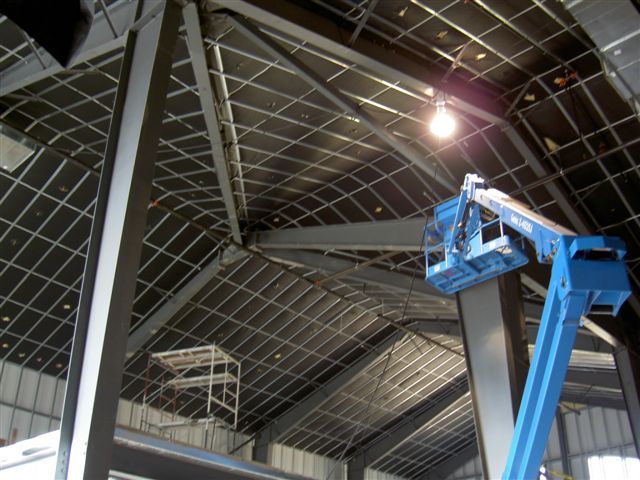Insulation and Water
by Christopher Brinckerhoff | 3 May 2021 12:00 am
Insulation materials are affected by water in a variety of ways

Banded liner system with fiberglass insulation in an ice rink. Photo courtesy of Therm-All Inc.
When water and insulation meet, and the insulation cannot be dried, the details of the roof or wall assembly the insulation is a part of affect the interaction between the two.
In terms of causes, lots of different factors can allow water to enter a building. Failure to divert rainwater on the outside of a building is the most common way water gets in. Other ways include water vapor entering by air movement through windows, doors and wall assemblies, and diffusion of water vapor through floors, walls and roofs. Moreover, water is often brought inside for production, cooking, cleaning and other purposes.
In cases where water vapor diffusion is the source of water getting inside, factors including building use and the temperature of, and humidity in, the inside versus outside air can be drivers.

Exposed fire rated polyisocyanurate rigid board insulation in walls. Photo courtesy of Therm-All Inc.
Fiberglass
Fiberglass, rigid foam boards and spray foams are some of the most popular insulation materials. Dean Moody, president at Intermountain West Insulation Inc. in Kennewick, Wash.[1], says, “Most insulation, what will happen when moisture hits it, whether it be fiberglass or blown-in fiberglass or cellulose, even open-cell spray foam, it will just hold the moisture like a sponge.”
Foster Lyons, president at Foster Lyons Building Science LLC in Trumbull, Conn.[2], describes fiberglass insulation as “fiberglass strands about the thickness of a human hair; they’re jumbled together similar to wool when it’s shorn off a sheep.” The fiberglass is attached to facers, producing batts.
In certain conditions, airspaces within fiberglass strands can fill with moisture. Bill Beals, district manager and building codes specialist at Therm-All Inc.’s office in Winslow, Maine[3], says with regard to fiberglass, when it retains moisture, it doesn’t insulate as well. But if it’s in an assembly where it can fully dry out, it regains its insulating ability. “The thermal performance [of fiberglass insulation] deteriorates because water is a conductor of heat, so your thermal properties are diminished. But once dry, typically the structure in fiberglass batts is unaltered. The thermal performance is recovered to its fully dried performance.”
In colder climates, moisture typically collects in fiberglass batts in metal building roofs, Beals says. “Fiberglass batts cycle in and out of moisture condensation in the winter. Then in the summer, that’s when they dry themselves out. There’s nothing that’s changed structurally in the fiberglass that makes them deteriorate in performance over the years.”
In roof and wall assemblies with fiberglass that don’t have a good way to dry out, water damage can occur. Moody says, “A lot of times in those systems, [fiberglass acts] pretty much like a sponge where it will hold the water and not let it out for a long time. If there’s no way for it to dry out, it’ll just retain that moisture forever. If there’s anything in [the cavity] that’s organically based, it could result in mold growth; maybe there’s some plywood sheeting. If there are water leaks, the facing will usually hold the water. But if the water can get down to a seam and drain out, you’ll usually see it because it will leave a little residue.”

Exposed fire rated polyisocyanurate rigid board insulation in a roof. Photo courtesy of Therm-All Inc.
Rigid Board
Compared to fiberglass, rigid board insulation has much smaller airspaces that moisture can fill. Unlike sheep wool, rigid board insulation in buildings is more akin to insulation in camping coolers, for example, Lyons says. “It’s like a white Styrofoam coffee cup.”
In construction, two common types of rigid board insulation are extruded polystyrene (XPS) and expanded polystyrene (EPS). “XPS is a foam, just like when you shampoo, it’s foam that has solidified,” Lyons says. “The chemistry in it takes a regular, soft foam that polymerizes and becomes stiff. The problem is, some of those foam bubbles pop as the whole thing is getting stiff. So, it’s not entirely without some passageways.”
While the chemistries of XPS and EPS are similar, in terms of structure, they’re different, Lyons says, “The way to think about EPS is it’s made up of little balls of XPS. If you looked at a whole bag of ping pong balls, you would immediately see that there are little spaces between those ping pong balls. EPS insulation is just like that, very small ping pong balls. They are very tiny spaces, but they’re there nonetheless.”
Comparing the two, Lyons says, “You can imagine a bunch of ping pong balls in a bag (EPS), it’s pretty easy to find a pathway between them. If it’s XPS with only a few popped bubbles, it’s harder to find a pathway between them. But in both cases, give it enough time and the right conditions, and you can get water in there.”
Rigid board insulation tends to repel water, depending on temperatures and humidity levels, Beals says. But joints between the boards, when not properly overlapped and sealed, can become susceptible to water migration.
“Board insulations are going to maintain their R-value at all times,” Beals says. “There can be moisture problems with boards around the joints, where they’re somewhat vulnerable if they’re just a square edge. That’s why they make you do a double layer in a rubber roof, two layers of board with the seams staggered and taped. That typically keeps any warm, moist air from penetrating the layers. But in a metal building, it’s typically done in one single layer and you have to have use either tongue-and-groove or shiplap edges with caulking and tape. If any of those are not done, the moisture will go around the board, up above the board and condense on the roof, fall back on the board and find a place to drip out. Your roof is sacrificed more than your thermal performance by having moisture against it for a long period of time.”

Retrofit facing on a church ceiling with blown-in fiberglass insulation. Photo courtesy of Intermountain West Insulation Inc.
Spray Foam
Spray foam insulation is quite different than fiberglass and rigid board not only by how it performs, but also by how and where it is installed.
The two most common types of spray foam insulation are open cell and closed cell spray polyurethane. For open cell, Lyons says, “Think of it as a bunch of foam where the vast majority of the bubbles are popped, but they still somehow kept their shape. In closed cell, all the bubbles are together for the most part, so there’s no easy way through it.”
Beals says, “Open-cell foam insulation can allow moisture through the finished product and can retain moisture. It does not have any vapor barrier capabilities unless a separate product is used like a 6-mil poly to cover the open-cell product. Closed-cell foam performs quite well and has vapor barrier capabilities.”
- Intermountain West Insulation Inc. in Kennewick, Wash.: https://iwinsulation.com/
- Foster Lyons Building Science LLC in Trumbull, Conn.: https://fosterlyons.com/
- Therm-All Inc.’s office in Winslow, Maine: http://therm-all.com/
Source URL: https://www.metalconstructionnews.com/articles/insulation-and-water/